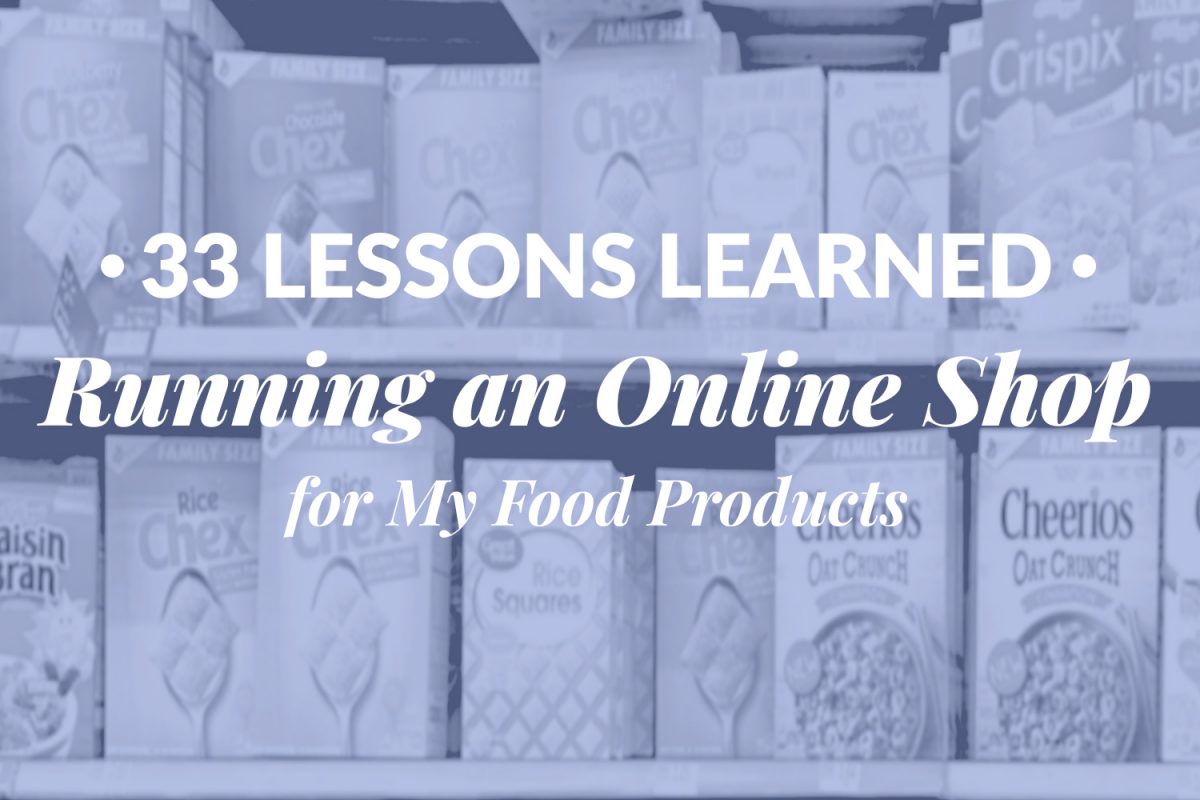Photo credit: Franki Chamaki
There is designing an online shop, and there is selling food online. As a web designer, I knew how to develop e-commerce websites, but generating sales online requires quite a different set of skills.
For three years, I owned a small specialty food business, called Cheese Companions (cheese accompaniments). Here are 33 marketing and sales lessons I learned from running my online shop.
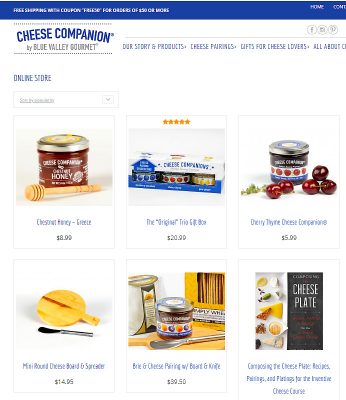
The questions answered in this article:
- Why Have a Food Online Shop?
- Which E-Commerce Platform Should You Choose?
- How to Design Your Online Shop?
- How to Maximize the Performance of Your E-Commerce Website?
- How to Select Products and Set Prices?
- How to Track Sales Performance of Your Online Store?
- How to Get More Traffic to Your Online Store and Get More Sales?
A. Why Have a Food Online Shop?
-
Buying food online is growing
You may have heard food businesses say, “people don’t buy food online.” As you know, it is less and less the case. Otherwise, Amazon would not have bought Whole Foods! However, we are not Amazon, and yes, people don’t buy all their food online. Think about your habits. Do you buy food online? If so, what and when do you purchase? Generally, people buy online when they need a gift for someone and don’t want the trouble of shipping it or when they cannot find a specific item at their local store (for instance, a traditional product from their home country). In the case of Cheese Companions, we discovered that around 90% of our online orders were shipped to a different address than the buyer (gifts).
Note: Things are a bit different today in the context of COVID-19.
-
Broadening your geographical reach
There is a clear benefit to selling online. As a small food business, even if you have a couple of distributors, you rarely sell beyond your region. With an online store, suddenly, sales are coming from around the country. It’s an excellent business expansion opportunity.
-
Broadening the type of purchases
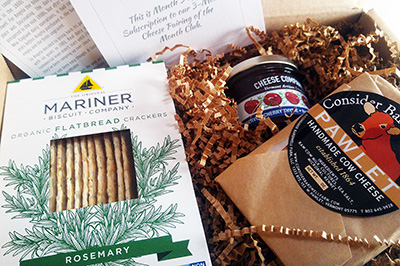
Not only are you expanding your business geographically, but if your products can “fit” the gift category, you can also grow your business beyond what you can sell in stores. As an example, my Cheese Companions jars were sold as singles or trios in retail stores, but online I created gift baskets with cheese knives, boards, and even local cheese. I also offered 3- and 6-month subscriptions, where people receive a cheese and an accompaniment each month. It is something that I would not be able to sell in local stores.
-
Testing product ideas at low cost
An online store also allows you to test new product ideas without manufacturing large quantities for the retail market. A word of caution, however: it’s essential to have professional-looking packaging and photography for the tests to be valid. Without it, you may come to the wrong conclusion that your products don’t raise interest when the reality is that your marketing is the issue.
-
Maximizing opportunities for upselling and cross-selling
Online it is easy to upsell and cross-sell, inciting customers to buy more. E-commerce platforms come with such functionality. You can show “related” products each time a customer views a product. You cannot do this in retail stores, and it is a real chance to increase “basket value,” i.e., the total dollar value of a customer’s order.
-
Selling products with shorter shelf-life
Retailers won’t take products with short shelf-life. It makes sense. But online, your products don’t “sit on shelves,” and you know that customers will eat them within a reasonable time. For Cheese Companions, we could sell items with a 3- to 6-month shelf-life, which we couldn’t sell to retailers.
-
Getting direct customer feedback
That’s one of the best things about an online store. You can have one-on-one conversations with customers. You can email them and ask for feedback, and they will write reviews. Again, it is not possible in the retail environment.
You also get quantitative feedback by tracking your “top sellers.”
-
Building a customer email list for future reach-outs
Online marketers know the value of email lists, which allow them to reach customers regularly. With an online shop, you gather emails from people who purchase your products and can develop e-newsletter campaigns to stay in contact with them.
B. Which E-Commerce Platform Should You Choose?
It is a crucial decision to make. You’ll find numerous articles online comparing various e-commerce platforms, listing the pros and cons of each one. If you’re looking for a comprehensive solution that you can implement without the help of a web designer, you should look at Shopify and Square.
Here are some links discussing those solutions:
If you already have a WordPress website (or want to launch one) and want more flexibility and lower monthly costs, look at WooCommerce. As a web designer, I am biased towards WordPress and WooCommerce. I love the freedom to get the “look and feel” that I want and add lots of additional functionality to my website and shop. In terms of costs, monthly costs charged by Shopify or Square can quickly be higher than the hosting costs of a self-hosted WordPress site.
What you should check to make your decision: costs, design flexibility, SEO (search engine optimization) for site search visibility, performance (upload speed), integration with your website, payment gateways, and functionality options.
C. How to Design Your Online Shop?
The must-haves for your online shop:
-
Photography
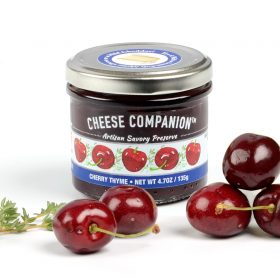
Professional photography is simply a must. There are numerous articles on the topic. According to an Etsy study, 90% of buyers say that photography quality is the top factor in their product selection. It is surprising to see that many online businesses still have product images of poor quality. So, whether you’re trying to rent your house as a vacation rental, or sell your food products, invest in photography. If you don’t have the skills, hire a photographer.
If you want to do it yourself, here are a few tips for you:
- How great product photographs influence e-commerce websites conversions
- Food Photography: 10 Simple Tips for Beginners
-
Detailed descriptions
Have you ever tried to find some product specifications on Amazon (watts, weight, size, materials, etc.) and were frustrated that you could not find the info?
Make sure that your products have all the details that a customer may want to know. If you get a question on a product, use that knowledge to improve your product description. It will help you sell.
-
Reviews vs. tastings
You’re selling food online, but people cannot taste it. In this context, reviews reassure customers that they are not making a mistake buying your product. Not only it builds customer’s trust, but it provides you with valuable feedback.
Make sure to follow up with buyers and encourage them to leave a review. Also, make sure to give them some instructions on how to do so: some platforms are a bit confusing when it comes to leaving a review.
-
Money-back guarantee
That’s another way that customers feel comfortable about buying. I believe that a money-back guarantee is a must for your online store.
-
Upsell/Cross-sell
One of the powerful tools you have online is to show “related” products to your visitors. It can be an accessory (“add-on” product), a more expensive alternative option (upsell), or a complementary product in the same category (cross-sell) that the customer may also want to buy. In this area, e-commerce platforms allow you to be almost as good as Amazon!
-
Defining territories
Of course, you don’t want to have to ship a product to India! But you can simply decide which state, province or country you want to sell to.
-
PayPal and credit cards
You can offer several payment methods to your online customers. My experience is that PayPal, with the option of paying with credit cards, works well. Stripe is also a popular payment platform.
Beyond those “must-haves,” there are endless features you can add to your shop.
You can set up, just to name a few:
- payment options,
- shipping options (pick-up and delivery, fixed or variable shipping costs, UPS, USPS, Canada Post options),
- gift certificates,
- “dependent” and add-on products (products that you can only buy as an “add-on” to another product.)
I used WooCommerce for Cheese Companions and now for my clients. Because it is an open-source platform, we can find plugins for it for all kinds of functionalities.
D. How to Maximize the Performance of Your E-Commerce Website
I’ll talk about sales performance in a later section.
Let’s talk first about your store’s technical performance.
-
Understand Performance (hosting and platform)
One of the challenges in recent years is that the size of web pages has significantly increased, mainly due to the high pixel density required on mobile devices (retina display). It slows down websites. From an average web page weight of 0.7MB in 2010, it reached 4MB in 2019. See the article: Webpage Size – Why is it important? And how do you optimize it?
But website visitors are still impatient when it comes to viewing a web page. According to a 2009 Forrester Consulting study, 47% of web users expect a page-load of 2 seconds or less. Approximately half of the visitors will leave a website if it doesn’t load in 3 seconds.
So you must invest in website performance. That includes not being cheap on hosting, having a well-designed website platform to ensure low page load times on desktop and mobile, optimizing your images, and more.
You can test your website page load times here: WebPageTest.
-
Offer Great User Experience on Mobile
We used to say that people were not buying on their smartphones and mobile devices. It is time to revise that belief. According to this 2020 OuterBox article, during the 2018 Holiday Season, almost 40% of all online purchases were made on smartphones.
-
Regularly Check if Everything Works on Your Store
We were early December 2017, and most of Cheese Companions’ online annual sales were going to happen in the following two weeks!! But our online store had an issue that we only discovered around December 15th, even though everything had worked perfectly for the past two years! That was a painful lesson and one we were not ready to forget: You must surf and test your website and online store regularly to make sure everything is working fine, at least monthly, and at least weekly when we have a promo or during the Holidays.
E. How to Select Products and Set Prices?
-
Cutting the middle man – setting up prices
We often discussed the topic of pricing with other small food businesses.
The conclusion is clear: if you are selling to retailers, don’t sell your products at a lower price online. Your retailers won’t like it, and you will read below about handling costs you have to fill up each order. So selling cheaper online is not a smart decision.
-
The promise of free shipping
There is no doubt that free shipping is a strong incentive for customers. They look for it. Consider including handling and shipping costs in your price. If you cannot, at least offer free shipping for orders over a certain dollar amount. I have often seen customers buy more, just to get free shipping.
-
Create products for the gift market
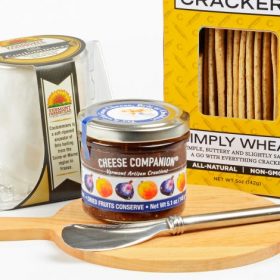 I already mentioned the gift market. If you can, make sure to create products to serve that market. You can design gift baskets with your products and partners’ products. You can offer gift certificates.
I already mentioned the gift market. If you can, make sure to create products to serve that market. You can design gift baskets with your products and partners’ products. You can offer gift certificates.
-
Get customers’ feedback to improve product selection
Customers’ feedback will also be of help when deciding which products to sell in your store.
-
Understand handling costs
Don’t underestimate the time it takes to fill an online order. You need to print the order, get the products, wrap them, get the UPS or USPS labels, organize the pick-up, or bring to the UPS depot or post office. That could easily take 20 to 30 minutes for one order. That’s a labor cost.
Consequently, you should set a minimum order size or sell products by packs of 3 or 6, for instance.
Ideally, you should also set up a shipping station to minimize handling times.
For those reasons, I have seen some food manufacturers abandon the online market, and focus on manufacturing and selling to the retail market. With COVID-19, that might change, however!
-
Understand shipping costs
You must decide the shipping costs for your online store. We dedicated an article on the topic of shipping: “How to Manage Shipping in Your Food Online Shop”.
Prices vary greatly depending on your product and on the shipping method you select.
And, with your online store, you are now entering the B2C business: direct to the consumer! It is essential to know that shipping to a residential address is more expensive than shipping to a business address. At least it is true with companies like UPS.
There are a number of options you can choose from: free shipping, fixed cost per order, fixed cost per item, fixed costs varying per region (distance shipped), variable costs from UPS, FedEx, USPS, Canada Post rates. They each have their pros and cons which we discuss in detail in the article “How to Manage Shipping in Your Food Online Shop”.
The post office or courier rates can be offered to your online customer, through the use of Woocommerce plugins. This is clearly the best method to make sure not to lose money on shipping orders to your online customers.
F. How to Track Sales Performance of Your Online Store?
You will likely promote your company and store on social media or in search engines.
You should set up e-commerce Google Analytics data to get this essential information:
- Where does your traffic come from? Search engines, social media, paid ads,
- Which web pages do your visitors land on,
- What is the flow of users from the product page to the cart and checkout: Abandoned carts are a crucial issue with e-commerce, and you must understand where you’re losing customers,
- Which products interest visitors and which products sell: Look at traffic and revenues.
- What is the seasonality of your sales: Many online stores will see 50% of their sales during the holiday period. Understanding the seasonality of your sales allows you to plan for promotions for quieter periods and other occasions.
If you build your store with WooCommerce, you can simply install the WooCommerce Google Analytics free plugin.
You can also look at the more expensive new application by Oribi.
G. How to Get More Traffic to Your Online Store and Get More Sales?
If you set up your shop and wait for sales, you are going to be deeply disappointed. I have heard small businesses set up hundreds of products online and see no sales.
In our article “28 Lessons Learned: Small Food Business – Key Factors for Success,” we talked about various online marketing tactics.
Some of those tactics are great to promote your online store:
-
Write blog articles and be visible on social media
You are passionate about your products. Share that passion by writing a blog or by creating photography on social media, which exults that passion. It will bring visitors right to your website.
-
Find ambassadors
They have the same passion as you, and they will share it on social media.
-
Develop an e-newsletter campaign
People who already purchased are more likely to buy again, so sharing special promotions or interesting articles is an efficient marketing tactic.
-
Check what your competition is doing
There are always things we can learn and improve, and some ideas we can grab from paying attention to the market.
Then there are tactics specific to e-commerce:
-
Encourage customer reviews
We’ve talked about it before. Reviews are a must for the success of your online shop. Make sure you reach out to your customers to get reviews. That is something you can also automate. If your business is a restaurant, you can also share TripAdvisor’s ratings of your restaurant.
-
Create products with partners
You can expand your product line by adding partners’ products on your site, and they will add yours to their stores as well. It works particularly well with gift baskets, which include both products. With Cheese Companions, we had such partnerships with local cheesemakers.
-
Create Gift Guides blog posts
With Cheese Companions, we wrote a series of gift guides for various types of cheese lovers. They each included one of our products and 9 to 12 other products. Not only can it generate product sales, but it also brings some Amazon affiliates dollars.
-
Don’t miss special occasions for promotions
I find that a bit crazy, but in the US, every day of the year, there is something to celebrate. I have seen some food manufacturers take advantage of it to create a special promotion or share on social media. See the National Day Calendar.
And then there is Valentine Day, Easter, Mother’s Day, Cyber Monday, Thanksgiving, Black Friday, etc. Statistics prove that sales are high on those occasions. However, customers may expect significant discounts on days like Cyber Monday or Black Friday, something you may not be ready to do.
Well, I genuinely hope that this gave you lots of marketing and sales insights to run your food online shop.
I learned a lot while selling my Cheese Companions online. I am grateful for the experience.
Today, it helps me when designing online shops for clients.
Further readings:
- Lessons learned from running a small food business – Part 1
- Lessons learned from running a small food business – Part 2
Selling food online:
A Shopify case study: Hello Matcha
Website performance

